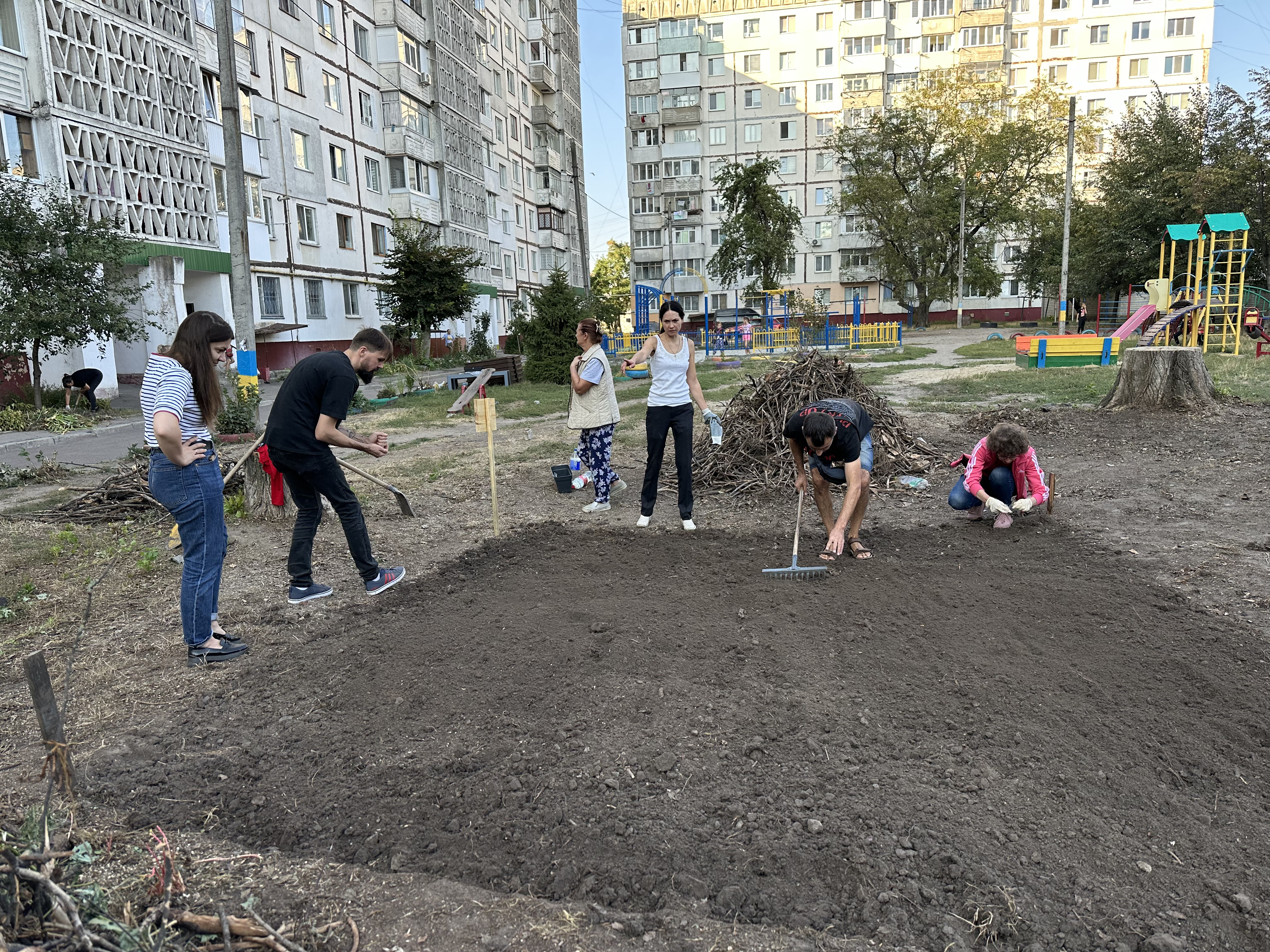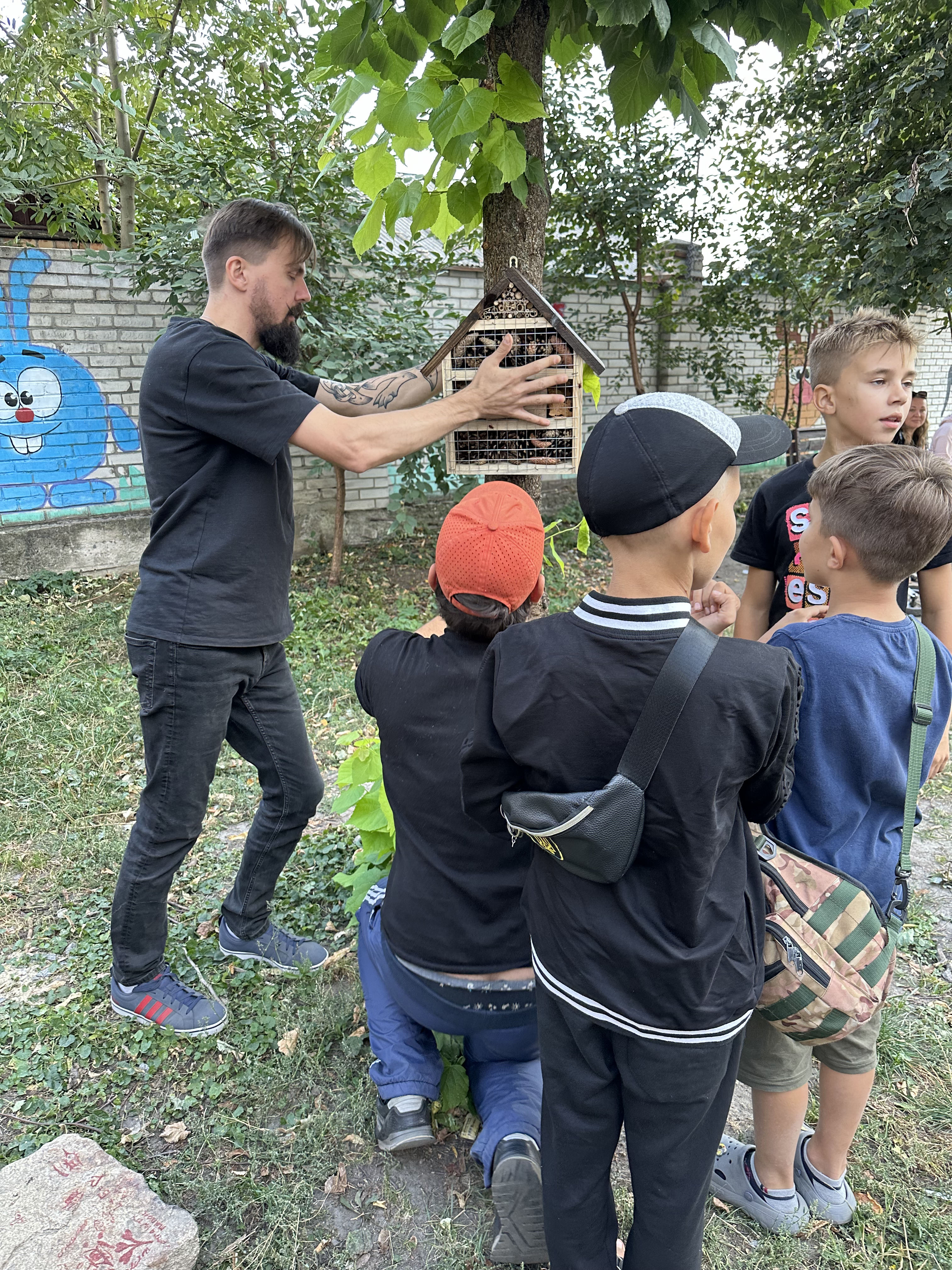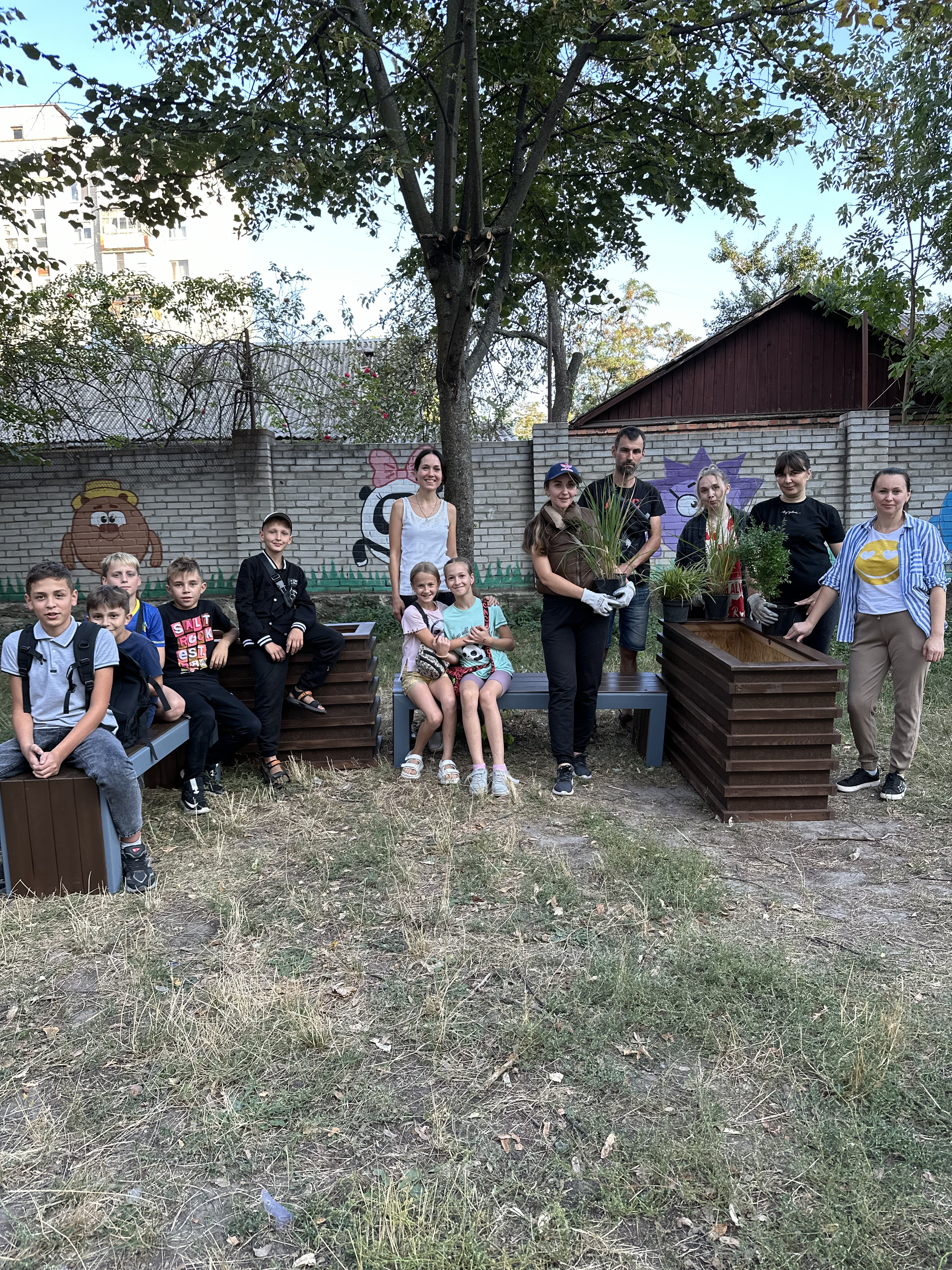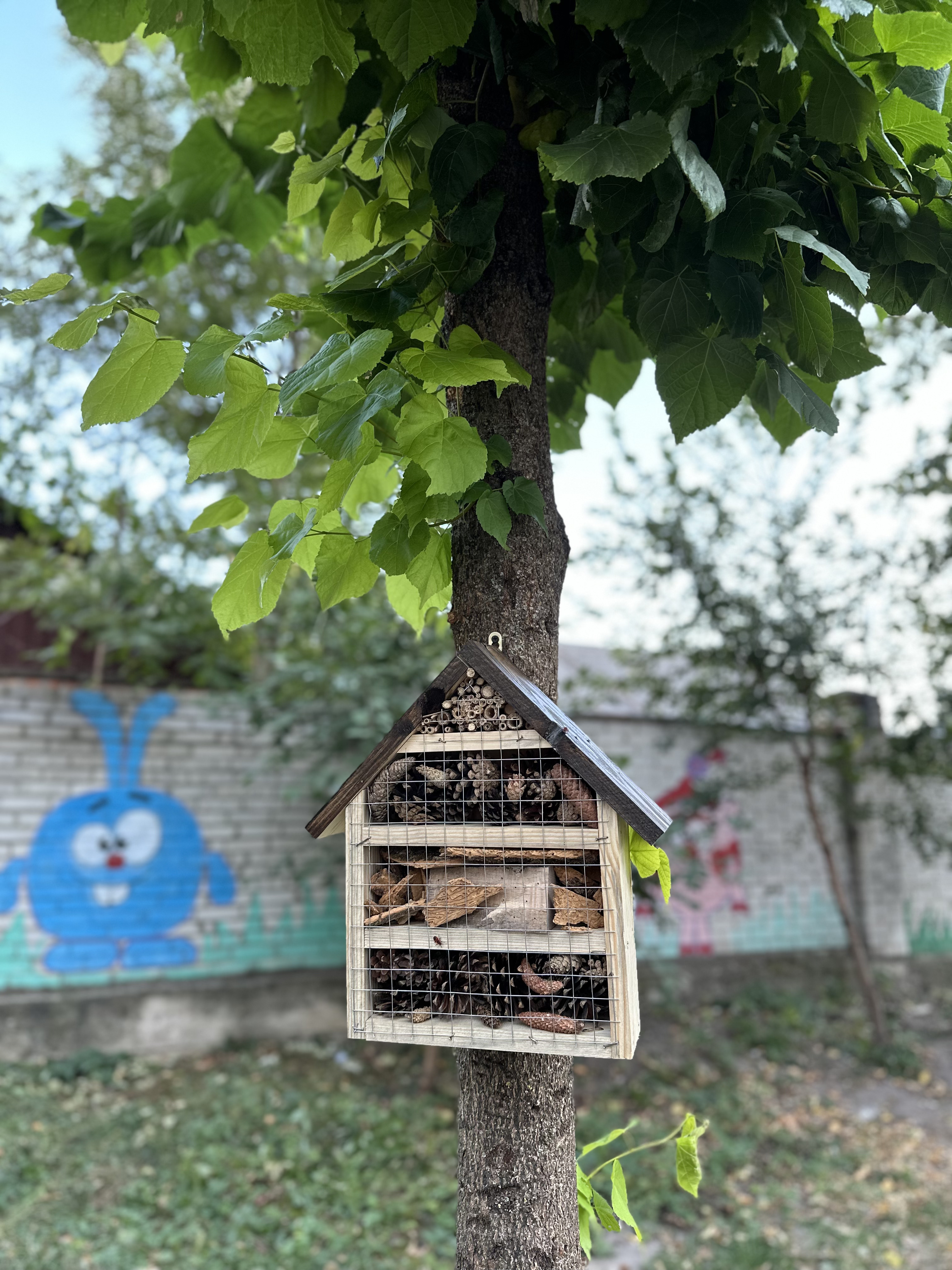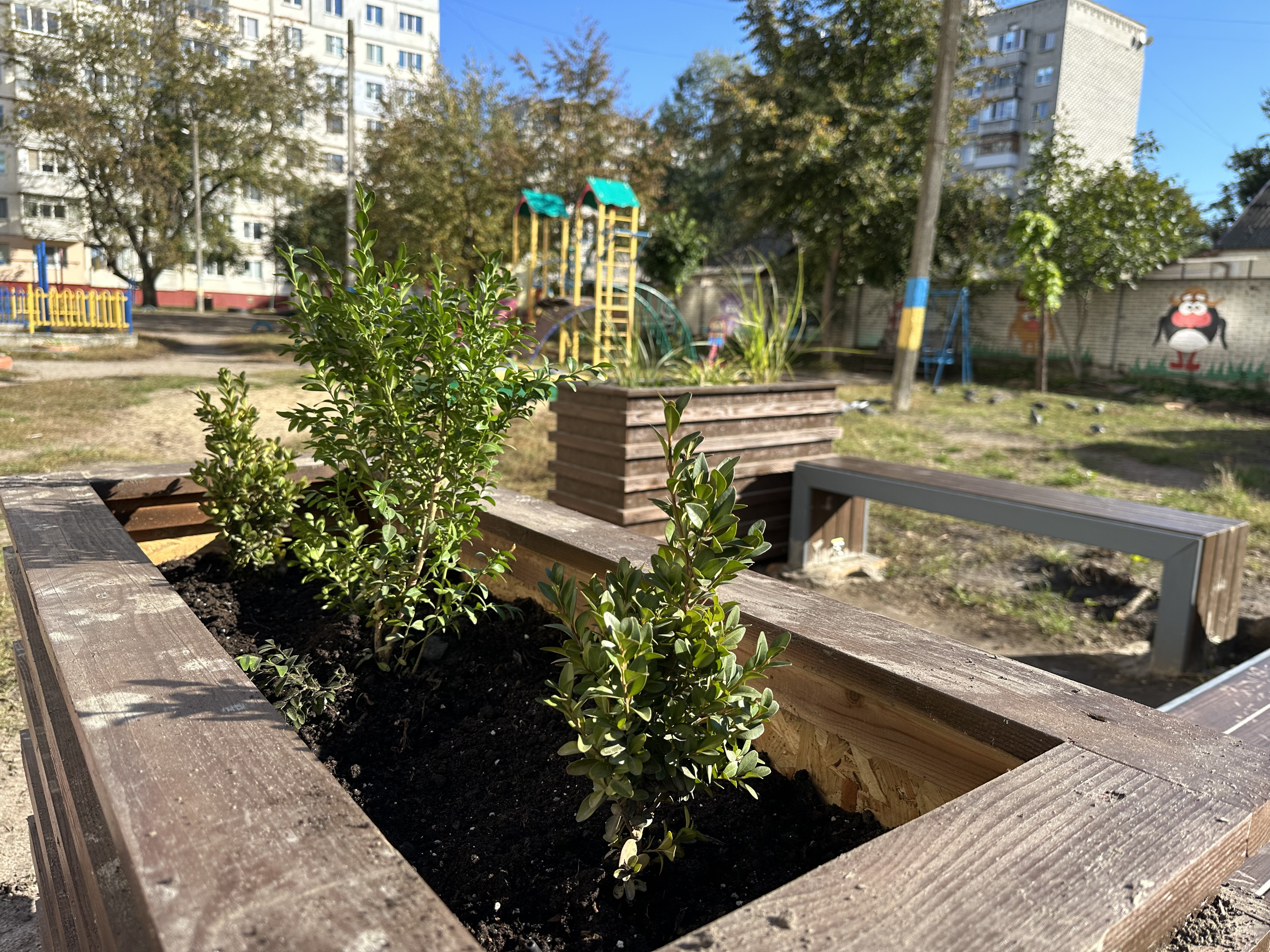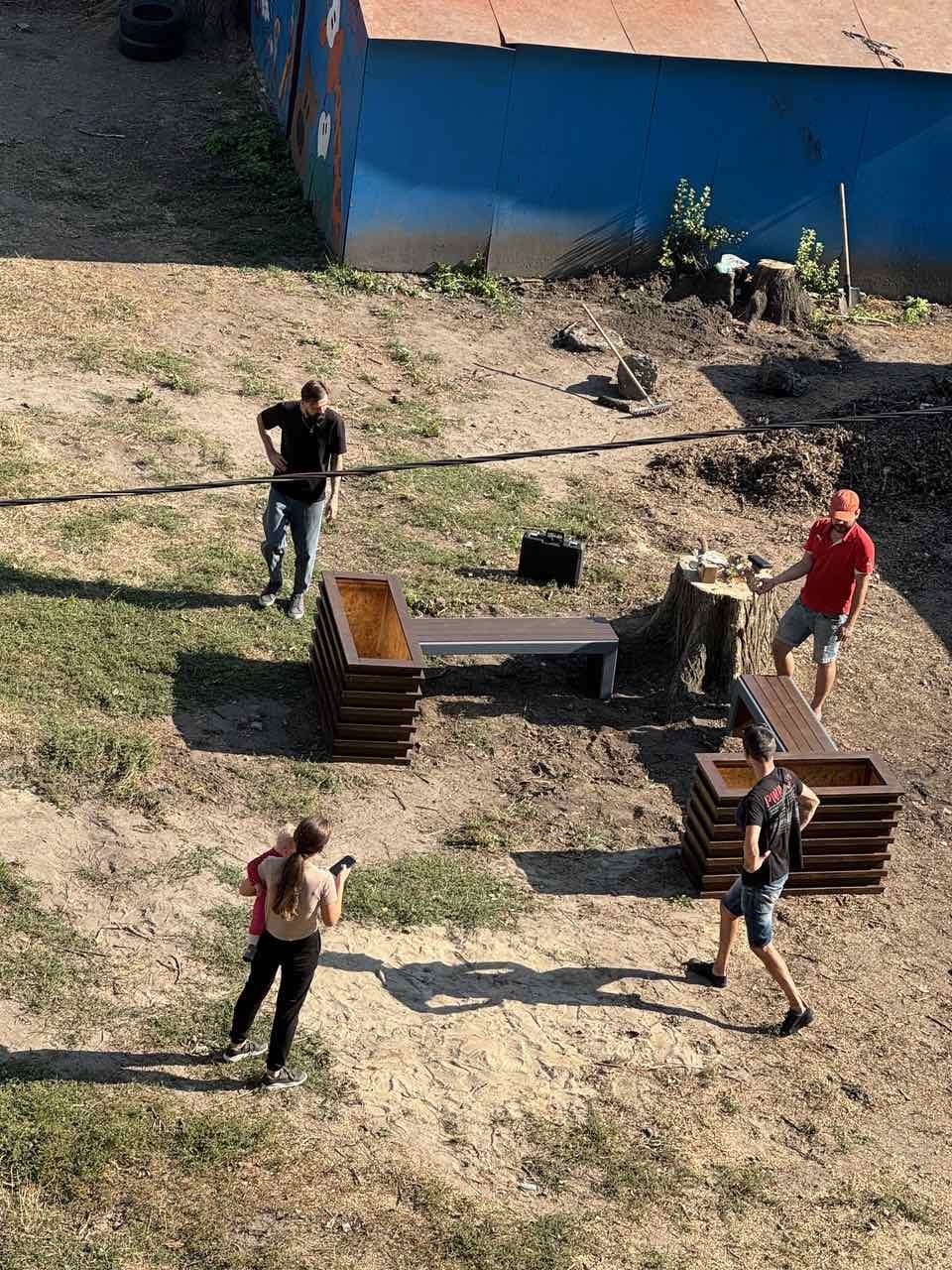Regaining a sense of belonging
Pocket yard
Pocket yard in Association of co-owners of the apartment building "Dovzhenka-39"
The Pocket Yard project is a transformation of the adjacent territory of an apartment building into a green, ecological and comfortable area for residents. Using nature-oriented solutions, residents have created a unique space for recreation, biodiversity and sustainable coexistence of the city and nature.
Ukraine
Local
Ukraine, Zhytomyr
Mainly urban
It refers to a physical transformation of the built environment (hard investment)
Yes
2024-09-28
No
No
No
As a representative of an organisation
Project goal:
"Pocket Yard" aims to rethink urban space by implementing sustainable nature-oriented solutions. The project contributes to the creation of green, environmentally friendly spaces that improve the ecological situation and quality of life of citizens.
Target groups:
• Residents of the Dovzhenko-39 condominium - 233 apartments, over 600 people
• Children, youth and the elderly
• Urban ecologists, urbanists and activists
• Public initiatives and representatives of local government
Specific goals and achieved results:
Creating a comfortable recreation area for residents
Improving the green balance and urban ecosystem
Involving the community in joint improvement
Developing environmental awareness through nature-oriented solutions.
Stimulating inclusivity and neighborly interaction.
"Pocket Yard" aims to rethink urban space by implementing sustainable nature-oriented solutions. The project contributes to the creation of green, environmentally friendly spaces that improve the ecological situation and quality of life of citizens.
Target groups:
• Residents of the Dovzhenko-39 condominium - 233 apartments, over 600 people
• Children, youth and the elderly
• Urban ecologists, urbanists and activists
• Public initiatives and representatives of local government
Specific goals and achieved results:
Creating a comfortable recreation area for residents
Improving the green balance and urban ecosystem
Involving the community in joint improvement
Developing environmental awareness through nature-oriented solutions.
Stimulating inclusivity and neighborly interaction.
Nature-based solutions
Biodiversity
Sustainable urban space
Environmental awareness
Community engagement
The main goals of the project in terms of sustainability were: Creating an ecosystem approach to landscaping and landscaping. Supporting natural processes without excessive intervention. Forming an environmentally conscious community
The “Pocket Yard” is an example of a scaled-up ecological transformation of urban spaces. Thanks to minimal financial investments, natural approaches and the involvement of residents, the model is easily reproduced in other places, contributing to the adaptation of the urban environment to climate change.
The “Pocket Yard” is an example of a scaled-up ecological transformation of urban spaces. Thanks to minimal financial investments, natural approaches and the involvement of residents, the model is easily reproduced in other places, contributing to the adaptation of the urban environment to climate change.
The aesthetic quality of the surrounding area directly affects the comfort, well-being and involvement of residents in interacting with the space. “Pocket Yard” is not just landscaping, but the creation of a new type of aesthetics, where natural beauty becomes an integral part of the urban landscape.
The main goals of the project from the point of view of aesthetics were:
Formation of a natural, harmonious environment
Creation of a visually attractive space through the use of natural forms and materials
Increasing the value of space through artistic and educational elements
The project demonstrates a new approach to urban beauty, when not artificial solutions, but natural processes become the main aesthetic value. It proves that sustainable design can be attractive, functional and integrated into the urban environment.
The main goals of the project from the point of view of aesthetics were:
Formation of a natural, harmonious environment
Creation of a visually attractive space through the use of natural forms and materials
Increasing the value of space through artistic and educational elements
The project demonstrates a new approach to urban beauty, when not artificial solutions, but natural processes become the main aesthetic value. It proves that sustainable design can be attractive, functional and integrated into the urban environment.
Modern cities need spaces that take into account the needs of different population groups. The Pocket Courtyard project was implemented with an emphasis on inclusivity - accessibility, involvement of residents and the formation of new social models of interaction.
The main goals of the project from the point of view of inclusion were: Creating accessible space for people of different ages and mobility. Forming a community involved in space management. Inclusion of vulnerable groups in decision-making processes
The Pocket Courtyard is a model of true public participation in creating a public environment. It shows that urban planning can be democratic when residents become active participants in the processes of change, and space is comfortable and accessible to all.
The main goals of the project from the point of view of inclusion were: Creating accessible space for people of different ages and mobility. Forming a community involved in space management. Inclusion of vulnerable groups in decision-making processes
The Pocket Courtyard is a model of true public participation in creating a public environment. It shows that urban planning can be democratic when residents become active participants in the processes of change, and space is comfortable and accessible to all.
The “Pocket Yard” project was initiated and implemented in close cooperation with the residents of the Dovzhenko-39 condominium, which ensured its effectiveness, sustainability, and compliance with the real needs of the residents.
The role of residents and the level of their participation:
• The initiative group of the condominium identified the problems of the space, formulated a vision for its transformation, and coordinated the implementation of the project.
• The residents of the building took direct part in planting plants, installing furniture, and setting up an insect hotel, which strengthened their responsibility for the common space.
• Children and youth were actively involved in environmental events and educational activities, which contributed to the formation of the environmental consciousness of the new generation.
• The elderly received a comfortable, accessible space for recreation, which increased the level of their socialization.
The role of civil society:
• Local ecologists of the initiative and urban planners advised residents on nature-based solutions and sustainable development.
• Civil society organizations helped to conduct educational events on biodiversity, preservation of urban ecosystems, and responsible management of adjacent territories.
The project showed that effective involvement of residents and civil society not only improves the quality of implementation, but also makes the space “alive” and filled with community values.
The role of residents and the level of their participation:
• The initiative group of the condominium identified the problems of the space, formulated a vision for its transformation, and coordinated the implementation of the project.
• The residents of the building took direct part in planting plants, installing furniture, and setting up an insect hotel, which strengthened their responsibility for the common space.
• Children and youth were actively involved in environmental events and educational activities, which contributed to the formation of the environmental consciousness of the new generation.
• The elderly received a comfortable, accessible space for recreation, which increased the level of their socialization.
The role of civil society:
• Local ecologists of the initiative and urban planners advised residents on nature-based solutions and sustainable development.
• Civil society organizations helped to conduct educational events on biodiversity, preservation of urban ecosystems, and responsible management of adjacent territories.
The project showed that effective involvement of residents and civil society not only improves the quality of implementation, but also makes the space “alive” and filled with community values.
For the successful implementation of the “Pocket Yard”, a multidisciplinary model of cooperation was created, covering different levels of management.
Local level:
• “Dovzhenko-39” condominium association is the initiator and executor of the project, responsible for the care and development of the territory.
• Zhytomyr City Council provided consulting support on environmental improvement and connected the project to city environmental initiatives.
• Local entrepreneurs and manufacturers ensured the supply of materials (furniture, information stands) from environmentally friendly resources.
National and European level:
• The project reflects the goals of the New European Bauhaus, demonstrating a model of adaptation of the urban environment to climate change.
Added value of involving different levels:
✔ The combination of community knowledge and expert environment made the project as effective as possible.
✔ Involving the authorities contributes to the further integration of such solutions into city policy.
✔ The project became a model for other condominiums seeking to transform their spaces.
Local level:
• “Dovzhenko-39” condominium association is the initiator and executor of the project, responsible for the care and development of the territory.
• Zhytomyr City Council provided consulting support on environmental improvement and connected the project to city environmental initiatives.
• Local entrepreneurs and manufacturers ensured the supply of materials (furniture, information stands) from environmentally friendly resources.
National and European level:
• The project reflects the goals of the New European Bauhaus, demonstrating a model of adaptation of the urban environment to climate change.
Added value of involving different levels:
✔ The combination of community knowledge and expert environment made the project as effective as possible.
✔ Involving the authorities contributes to the further integration of such solutions into city policy.
✔ The project became a model for other condominiums seeking to transform their spaces.
Multidisciplinary approach
The Pocket Yard project brought together residents, ecologists, urban planners, sociology, art and communications, which made it unique.
Ecology - identifying nature-based solutions to support biodiversity.
Urban planning - planning space taking into account the principles of sustainable development.
Landscape design - creating decorative meadows as an alternative to classic lawns.
Sociology - studying the needs of residents and developing a strategy for their involvement.
Art and design - creating visually appealing information materials.
Communications - developing campaigns that explain the benefits of the project to the community.
The Pocket Yard project brought together residents, ecologists, urban planners, sociology, art and communications, which made it unique.
Ecology - identifying nature-based solutions to support biodiversity.
Urban planning - planning space taking into account the principles of sustainable development.
Landscape design - creating decorative meadows as an alternative to classic lawns.
Sociology - studying the needs of residents and developing a strategy for their involvement.
Art and design - creating visually appealing information materials.
Communications - developing campaigns that explain the benefits of the project to the community.
The Pocket Yard project is innovative in several aspects:
1. Alternative approach to landscaping
Traditional: standard lawns that require constant care, watering, mowing.
Innovation: ornamental meadows as a long-term solution for biodiversity, reducing resource consumption and changing the aesthetics of urban spaces.
2. Open space for shared management
Innovation: residents of the condominium association became active managers and caretakers of the space, which created a model of shared decision-making.
3. Nature-oriented solutions in adjacent areas: in cities, priority is given to architectural or technical approaches to landscaping.
1. Alternative approach to landscaping
Traditional: standard lawns that require constant care, watering, mowing.
Innovation: ornamental meadows as a long-term solution for biodiversity, reducing resource consumption and changing the aesthetics of urban spaces.
2. Open space for shared management
Innovation: residents of the condominium association became active managers and caretakers of the space, which created a model of shared decision-making.
3. Nature-oriented solutions in adjacent areas: in cities, priority is given to architectural or technical approaches to landscaping.
The Pocket Courtyard project is based on an integrated approach that combines the principles of sustainability, ecological design, public participation and interdisciplinary interaction.
Main stages of the methodology:
The first step was to study the needs of residents, assess the existing state of the neighborhood and identify key environmental and social problems. Thanks to surveys, expert consultations and analysis of local conditions, a vision of future changes was formed.
Based on the information collected, a single concept was created that integrates environmental, aesthetic and social aspects. The key element was the use of nature-oriented solutions - from the creation of decorative meadows to the arrangement of an insect hotel, which ensures the support of biodiversity and the preservation of natural processes.
Residents became partners in their own landscaping: through practical participation in the work, they not only determined priorities, but also became direct performers. This level of participation contributed to the formation of a sense of shared responsibility and created the prerequisites for sustainable management of space in the future.
The project was implemented with the support of experts from various fields – ecology, urbanism, landscape design, sociology and communications. This multidisciplinary interaction allowed to ensure a balance between aesthetics, functionality and sustainability, transforming traditional landscaping into an innovative model of urban development.
This approach not only solves local problems – it sets a new standard for the transformation of urban spaces. Through active community participation and interdisciplinary collaboration, “Pocket Yard” demonstrates how small but strategically sound steps can create an ecologically balanced environment.
Main stages of the methodology:
The first step was to study the needs of residents, assess the existing state of the neighborhood and identify key environmental and social problems. Thanks to surveys, expert consultations and analysis of local conditions, a vision of future changes was formed.
Based on the information collected, a single concept was created that integrates environmental, aesthetic and social aspects. The key element was the use of nature-oriented solutions - from the creation of decorative meadows to the arrangement of an insect hotel, which ensures the support of biodiversity and the preservation of natural processes.
Residents became partners in their own landscaping: through practical participation in the work, they not only determined priorities, but also became direct performers. This level of participation contributed to the formation of a sense of shared responsibility and created the prerequisites for sustainable management of space in the future.
The project was implemented with the support of experts from various fields – ecology, urbanism, landscape design, sociology and communications. This multidisciplinary interaction allowed to ensure a balance between aesthetics, functionality and sustainability, transforming traditional landscaping into an innovative model of urban development.
This approach not only solves local problems – it sets a new standard for the transformation of urban spaces. Through active community participation and interdisciplinary collaboration, “Pocket Yard” demonstrates how small but strategically sound steps can create an ecologically balanced environment.
The Pocket Yard project is a unique model of urban space transformation, the elements of which have a high potential for reproduction and adaptation in various contexts - from small residential complexes to large urban areas.
The main reproduced element is an innovative approach to community involvement. The model, in which residents actively participate in space diagnostics, concept development and its implementation, creates a sense of shared responsibility. This format of public governance is easily adaptable to different social groups and can be used to implement projects in different cities, where the participation of residents in the improvement of territories is important.
The use of nature-oriented solutions - decorative meadows, insect hotels, areas with limited mowing - ensures not only the preservation of biodiversity, but also minimizes the use of resources. These elements can be easily transferred to other urban conditions, adapting them to local climatic and ecological features. Such technologies are becoming a powerful tool for changing traditional approaches to landscaping, demonstrating that sustainable urban planning can be both functional and aesthetically pleasing.
The main reproduced element is an innovative approach to community involvement. The model, in which residents actively participate in space diagnostics, concept development and its implementation, creates a sense of shared responsibility. This format of public governance is easily adaptable to different social groups and can be used to implement projects in different cities, where the participation of residents in the improvement of territories is important.
The use of nature-oriented solutions - decorative meadows, insect hotels, areas with limited mowing - ensures not only the preservation of biodiversity, but also minimizes the use of resources. These elements can be easily transferred to other urban conditions, adapting them to local climatic and ecological features. Such technologies are becoming a powerful tool for changing traditional approaches to landscaping, demonstrating that sustainable urban planning can be both functional and aesthetically pleasing.
The Pocket Yard project addresses a number of global challenges by transforming local urban spaces with nature-based solutions. Modern cities are facing the consequences of climate change, biodiversity loss, urban degradation and social isolation. Our approach demonstrates how local initiatives can be a powerful response to these global problems.
Through landscaping, creating ornamental meadows and areas with limited mowing, we not only cool the urban microclimate, but also contribute to the absorption of carbon dioxide. This allows us to reduce the “urban heat island” effect and adapt the local environment to climate change.
Innovative elements, such as an insect hotel, become centers of conservation of local fauna. This approach supports the restoration of natural ecosystems and contributes to the preservation of diverse species, which is critically important in the context of global biodiversity loss.
Involving residents in the planning, implementation and care of the space creates a strong foundation for civil society. Active community participation not only improves the quality of local environmental management, but also forms conscious citizens who are able to jointly overcome global social challenges.
Thus, the “Pocket Yard” is a vivid example of how local solutions can directly affect global problems. Integrating environmental technologies, sustainable design and active participation of citizens, the project creates a platform for the transformation of urban space, which contributes to adaptation to climate change, preservation of biodiversity and improvement of the quality of life of residents - all of which is of great importance in the context of global challenges of the modern world.
Through landscaping, creating ornamental meadows and areas with limited mowing, we not only cool the urban microclimate, but also contribute to the absorption of carbon dioxide. This allows us to reduce the “urban heat island” effect and adapt the local environment to climate change.
Innovative elements, such as an insect hotel, become centers of conservation of local fauna. This approach supports the restoration of natural ecosystems and contributes to the preservation of diverse species, which is critically important in the context of global biodiversity loss.
Involving residents in the planning, implementation and care of the space creates a strong foundation for civil society. Active community participation not only improves the quality of local environmental management, but also forms conscious citizens who are able to jointly overcome global social challenges.
Thus, the “Pocket Yard” is a vivid example of how local solutions can directly affect global problems. Integrating environmental technologies, sustainable design and active participation of citizens, the project creates a platform for the transformation of urban space, which contributes to adaptation to climate change, preservation of biodiversity and improvement of the quality of life of residents - all of which is of great importance in the context of global challenges of the modern world.
Residents of the Dovzhenka-39 condominium, which houses over 233 apartments, have access to a comfortable recreation area, which has a positive effect on physical and psychological health. Creating a cozy green space helps reduce the temperature and create a pleasant microclimate, typical of nature-oriented solutions.
Environmental education and activity: The project stimulates environmental awareness - residents are directly involved in caring for the territory, which turns them into active participants in sustainable development processes. An installed insect hotel, decorative meadows and information signs - all this not only decorates the space, but also serves as a living lesson in environmental protection activities.
Indirect benefits and social impact
Social cohesion: Active participation of the community in the implementation of the project contributed to the formation of new social models of interaction. Joint management of the space strengthened the sense of belonging and responsibility, which had a positive effect on interaction between residents and created a platform for further initiatives.
Scalability and impact on urban planning: The successful experience of transforming a residential area has become a model for other cities and communities. The model, based on the integration of nature-based technologies and active public participation, can be adapted at the regional, national and European levels. This opens up opportunities for creating a network of sustainable solutions that can respond to the challenges of climate change and biodiversity loss.
The project did not just improve the area - it changed the attitude of residents to their own space, turning an ordinary yard into an innovative center of sustainable development.
Environmental education and activity: The project stimulates environmental awareness - residents are directly involved in caring for the territory, which turns them into active participants in sustainable development processes. An installed insect hotel, decorative meadows and information signs - all this not only decorates the space, but also serves as a living lesson in environmental protection activities.
Indirect benefits and social impact
Social cohesion: Active participation of the community in the implementation of the project contributed to the formation of new social models of interaction. Joint management of the space strengthened the sense of belonging and responsibility, which had a positive effect on interaction between residents and created a platform for further initiatives.
Scalability and impact on urban planning: The successful experience of transforming a residential area has become a model for other cities and communities. The model, based on the integration of nature-based technologies and active public participation, can be adapted at the regional, national and European levels. This opens up opportunities for creating a network of sustainable solutions that can respond to the challenges of climate change and biodiversity loss.
The project did not just improve the area - it changed the attitude of residents to their own space, turning an ordinary yard into an innovative center of sustainable development.

